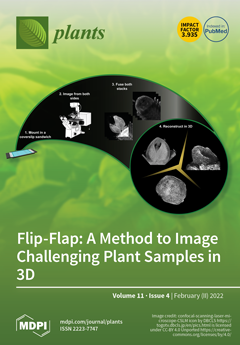The effect of olive (
Olea europaea) stem extract (OSE) on the viability of conidia of
Verticillium dahliae, the causal agent of Verticillium wilt of olive (VWO), is not yet well understood. Thus, the aim of this study was to determine
[...] Read more.
The effect of olive (
Olea europaea) stem extract (OSE) on the viability of conidia of
Verticillium dahliae, the causal agent of Verticillium wilt of olive (VWO), is not yet well understood. Thus, the aim of this study was to determine the influence of the olive genotype (cultivar resistance) and the interaction between olive cultivars and biocontrol treatments on the effect of OSE on conidial germination of
V. dahliae by
in vitro sensitivity tests. To this end, OSE from cultivars Frantoio, Arbequina, and Picual, respectively tolerant, moderately susceptible, and highly susceptible to
V. dahliae, were tested alone or after treatments with biological control agents (BCAs) and commercial products efficient at reducing the progress of VWO.
Aureobasidium pullulans strain AP08,
Phoma sp. strain ColPat-375, and
Bacillus amyloliquefaciens strain PAB-24 were considered as BCAs. Aluminium lignosulfonate (IDAI Brotaverd
®), copper phosphite (Phoscuprico
®), potassium phosphite (Naturfos
®), and salicylic acid were selected as commercial products. Our results indicate that the influence of biological treatments against the pathogen depends on the genotype, since the higher the resistance of the cultivar, the lower the effect of the treatments on the ability of OSE to inhibit the germination of conidia. In ‘Picual’, the BCA
B. amyloliquefaciens PAB024 and copper phosphite were the most effective treatments in inhibiting conidia germination by the OSE. This work represents a first approach to elucidate the role of cultivar and biological treatments in modifying the effect on the pathogen of the endosphere content of olive plants.
Full article






